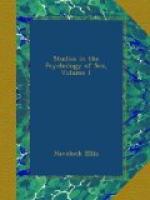[126] E. Smith, Health and Disease, Chapter III. I may remark that, according to Kemsoes (Deutsche medizinische Wochenschrift, January 20, 1908, and British Medical Journal, January 29, 1898), school-children work best on Monday and Tuesday.
[127] See Appendix B.
III.
The Annual Sexual Rhythm—In Animals—In Man—Tendency of the Sexual Impulse to become Heightened in Spring and Autumn—The Prevalence of Seasonal Erotic Festivals—The Feast of Fools—The Easter and Midsummer Bonfires—The Seasonal Variations in Birthrate—The Causes of those Variations—The Typical Conception-rate Curve for Europe—The Seasonal Periodicity of Seminal Emissions During Sleep—Original Observations—Spring and Autumn the Chief Periods of Involuntary Sexual Excitement—The Seasonal Periodicity of Rapes—Of Outbreaks among Prisoners—The Seasonal Curves of Insanity and Suicide—The Growth of Children According to Season—The Annual Curve of Bread-consumption in Prisons—Seasonal Periodicity of Scarlet Fever—The Underlying Causes of these Seasonal Phenomena.
That there are annual seasonal changes in the human organism, especially connected with the sexual function, is a statement that has been made by physiologists and others from time to time, and the statement has even reached the poets, who have frequently declared that spring is the season of love.
Thus, sixty years ago, Laycock, an acute pioneer in the investigation of the working of the human organism, brought together (in a chapter on “The Periodic Movements in the Reproductive Organs of Woman,” in his Nervous Diseases of Women, 1840, pp. 61-70) much interesting evidence to show that the system undergoes changes about the vernal and autumnal equinoxes, and that these changes are largely sexual.
Edward Smith, also a notable pioneer in this field of human periodicity, and, indeed, the first to make definite observations on a number of points bearing on it, sums up, in his remarkable book, Health and Disease as Influenced by Daily, Seasonal, and Other Cyclical Changes in the Human System (1861), to the effect that season is a more powerful influence on the system than temperature or atmospheric pressure; “in the early and middle parts of spring every function of the body is in its highest degree of efficiency,” while autumn is “essentially a period of change from the minimum toward the maximum of vital conditions.” He found that in April and May most carbonic acid is evolved, there being then a progressive diminution to September, and then a progressive increase; the respiratory rate also fell from a maximum in April to a minimum maintained at exactly the same level throughout August, September, October, and November; spring was found to be the season of maximum, autumn of minimum, muscular power; sensibility to tactile and temperature impressions was also




